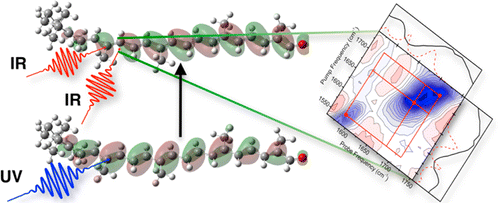TRIR and 2DIR Spectroscopy
Time resolved infrared (IR) spectroscopy is highly informative about the structural modifications occurring upon photoexcitation in molecular systems. We have developed infrared based pump-probe spectroscopy, where the excitation pulse can be either a visible pulse, enabling electronic excitation, or a an infrared pulse, enabling transitions among the vibrational levels of the system under investigation in the electronic ground state.
Our laser system is based on a Ti:sapphire regenerative amplifier (Coherent Legend) pumped by a Ti:sapphire oscillator (Coherent Micra). The system produces 1KHz, 40 fs pulses at 800 nm, with output power of about 3W.
Infrared pump pulses are obtained by pumping a commercial Optical Parametric Amplifier (OPA) system (TOPAS, Light Conversion) with a portion of the fundamental laser radiation. The Near IR (NIR) signal and idler OPA output are frequency mixed through a non linear crystal to create pump pulses in the Mid-IR. By frequency doubling or by mixing the NIR signal or idler with residual 800 nm light, visible pulses can be obtained in the 450-700 nm spectral range. Pump pulses in the UV region can also be obtained by further second harmonic generation.
The IR probe pulses are generated by pumping a second, home-made, OPA. Before reaching the sample the probe pulses are delayed respect to the pump pulses by passing through a motorized stage. Pump and probe pulses are focussed and overlapped on the sample. Detection is achieved through a 32 elements MCT array.
The same setup can be extended for use as a 2DIR spectrometer. In that case a third IR pulse is sent to the sample, allowing to introduce a further time delay which translates into a second frequency axis upon Fourier transformation. Our system is implemented in a pump-probe geometry where two delayed pump pulses are produced by sending the TOPAS output through a Mark-Zender interferometer, while the probe pulse is produced through the second OPA.
If a visible pulse is sent to the sample before the pulse sequence used for measuring 2DIR spectra, it is possible to obtain Transient 2DIR spectra, which means to acquire differential 2DIR maps between an excited electronic state and ground state. You can read more about this experiment here.
